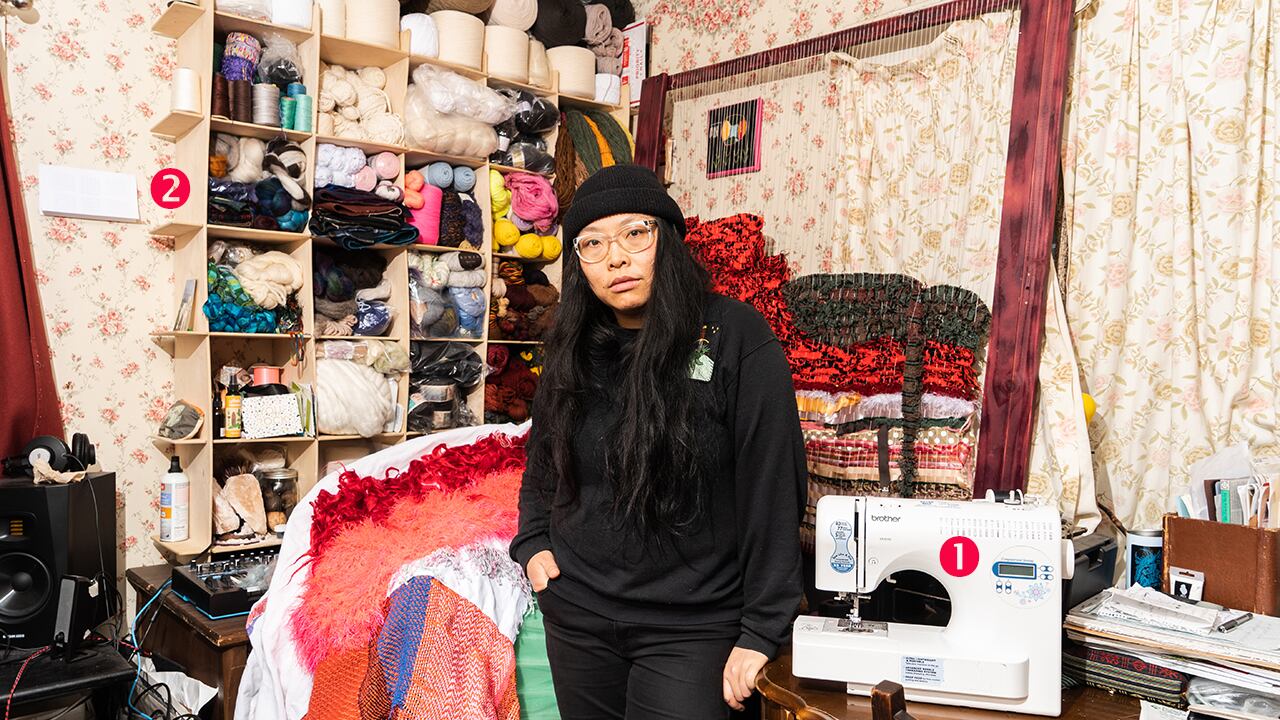After working four months with a tapestry company to create a textile for an upcoming show, Vo Vo ran into a problem: The company refused to print the design.
The tapestry depicts a stately building with Roman columns alight with squiggly, pastel-colored flames. On a corner of the blanket is the phrase "Burn it down."
After months of back-and-forth, the company balked, saying it couldn't support the "situation there in Portland, Ore." It's a fitting, if ironic, backstory for the New Zealand-born, Portland-based artist's new show, on display through April 1 at Fuller Rosen Gallery.
Things that have to do with fire was partially inspired by last summer's protests, and the misconceptions about Portland anarchists—and anarchism in general—that revealed themselves on a national level. Comprising video installations and cloth banners covered in illustrations and slogans, the gallery show is a response to the idea that anarchists are primarily devoted to destruction. But the exhibit isn't exactly a condemnation of Portlanders who have wagged their fingers at Vo and their peers for the past year. Rather, it's intended as a bridge.
"I do want to meet people at an entry point that feels accessible to them," says Vo, who has worked for years as a radical educator. "A lot of [the show is] jokes and signals to my fellow anarchists, and then some are for people who haven't maybe critiqued liberalism, who haven't looked at where liberalism comes from, and the idea of U.S. exceptionalism and individualism."
Despite its controversial subject matter, Things that have to do with fire isn't preachy. It's warm, discursive and heartfelt. And, like Vo themself, it's full of sly humor.
Vo sews and weaves much of their work. Looms, sewing machines and quality materials usually don't come cheap, but all the materials in their home work space were either gifts or bought at a discount.
"I'm someone who's experienced houselessness myself as an adult and as a child. I'm constantly making work as a survivor, and someone who's experienced these systems as a participant," says Vo. "I think that's been a struggle for people to understand, because they assume that when they walk into a space—especially a very nice looking space with art displayed—they kind of assume that the person who's making it comes from a specific position."
1. Sewing Machine
When Vo started their MFA at the Pacific Northwest College of Art two years ago, they thought they'd study illustration. Then they found a sewing machine on the side of a road. As a kid, Vo worked in a sweatshop with their parents, but they hadn't sat at a sewing machine since. "Me and my parents were part of a wider network of Vietnamese refugees who were employed illegally to make things in Australia for North American fashion companies," says Vo, who is Vietnamese. Not long after they took home the abandoned machine, Vo shifted their focus from illustration to textiles. "I do feel so comfortable when I'm at the machine making stuff, and it's because I did it for hours as a kid," says Vo. "But this time, I'm doing it for me and not for another company."
2. Yarn Collection
Vo's towering stash of yarn is stocked with luxurious skeins of wool from Uruguay, Lithuania and Australia. It's an astounding amount of high-quality yarn, but it took them less than a year and relatively little money to accumulate. "I think honestly my coping mechanism after COVID hit was to look at really cheap lots on eBay," says Vo. "I know what I like, but I'll only get it if it's free or if they're selling it on eBay for a really low price."
3. Storage Closet
Stuffed into a closet in the corner of Vo's workroom is two years' and dozens of hours' worth of work. A jacket might take an hour and a half—a surprisingly short period of time considering the clean lines achieved from cobbled-together, reclaimed fabrics. A weaved piece can take weeks. It's not uncommon for them to spend 12 hours a day in front of the sewing machine or the loom. "I get in the zone," says Vo. "That's why I chose to do what I'm doing, because I enjoy it."
4. Uniform Couch
Across from Vo's loom is a couch upholstered with U.S. Army uniforms from the Vietnam War, a piece from a show about immigration that Vo curated before the pandemic. Now, it almost blends into what Vo refers to as the "man cave" aesthetic of their basement workspace. "Even in the Southern Hemisphere, you're still bombarded with U.S.-specific films about the Vietnam War that center white dudes," says Vo. "All that this does is visualize that, even though that's an experience that I've had since I was a kid. My experience is always pushed aside for the Tom Cruise or the Charlie Sheen or whoever."

5. Loom
Last March, Vo came across a fortuitous Craigslist post: A woman in Ridgefield, Wash., was looking to get rid of a 3-foot tapestry loom. The loom was sitting in a barn, so it was rickety and caked with grass and horse manure. Vo fixed it up themself, and it now looks sturdy and elegant—you'd never guess it was salvaged from literal shit.
Though Vo attributes their resourcefulness to their experiences with homelessness and as an immigrant, it also seems essential to the philosophy behind Things that have to do with fire.
"When I used to mask up and protest before COVID, wearing a mask would immediately attract so much insults from older white women," says Vo. "I do hope those same women that would scream at us from across the road with disgust would drop that accusation for a second to try to understand that anarchists are not trying to destroy their world, they're trying to build better things."
Puppet Maker Katy Strutz's Basement Studio Is Full of Miniature Monsters and Multiple Bins of Hair
At Home, Filmmaker Alberta Poon Is as Much of a "Mood-Slash-Light Psycho" as She Is on Set
Jazz Musician Ezra Weiss Has Gone From Leading Big Bands to Playing Alone in His Home

